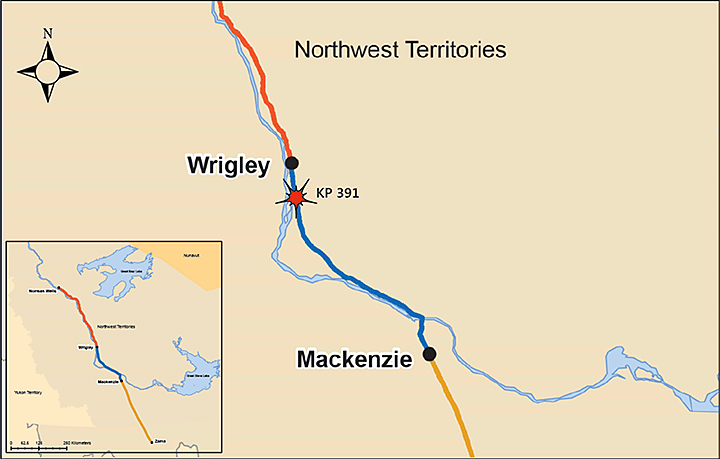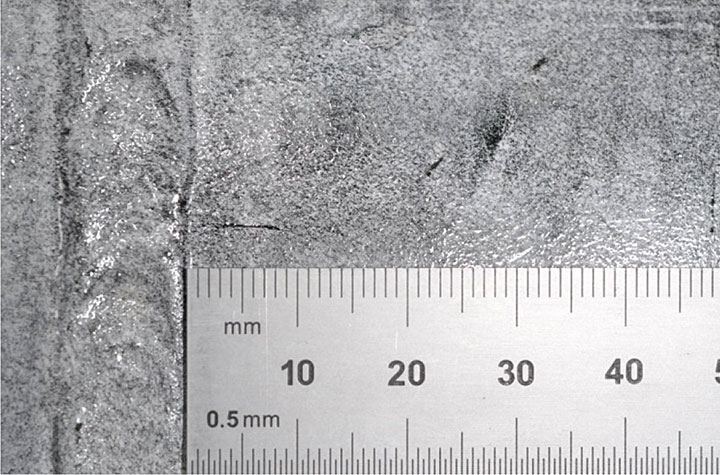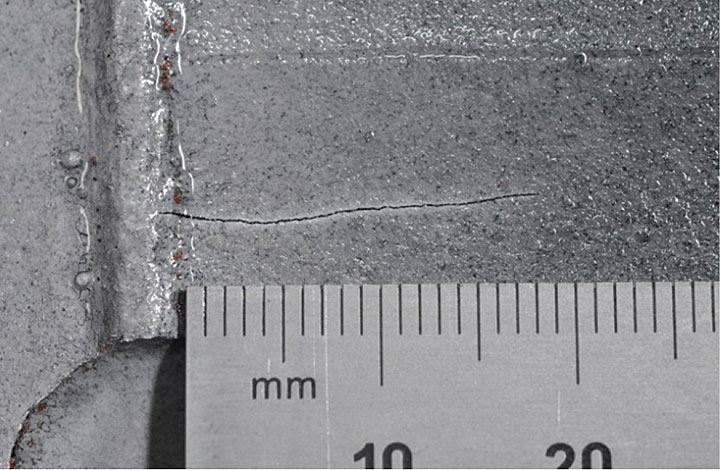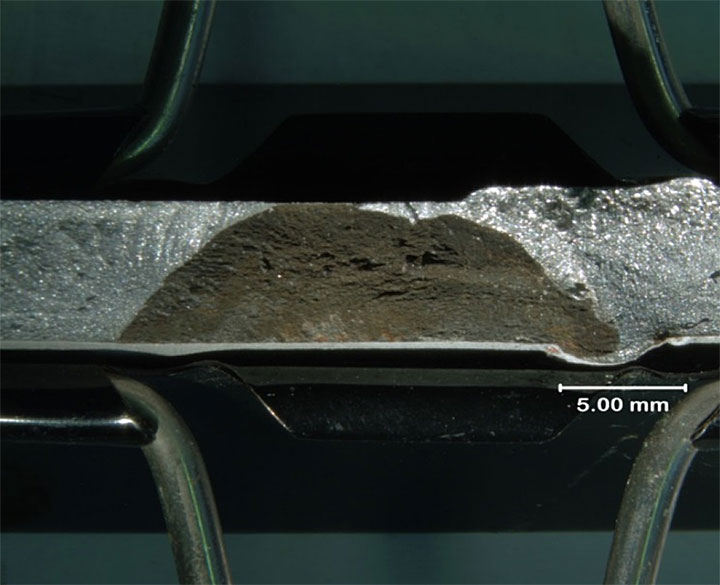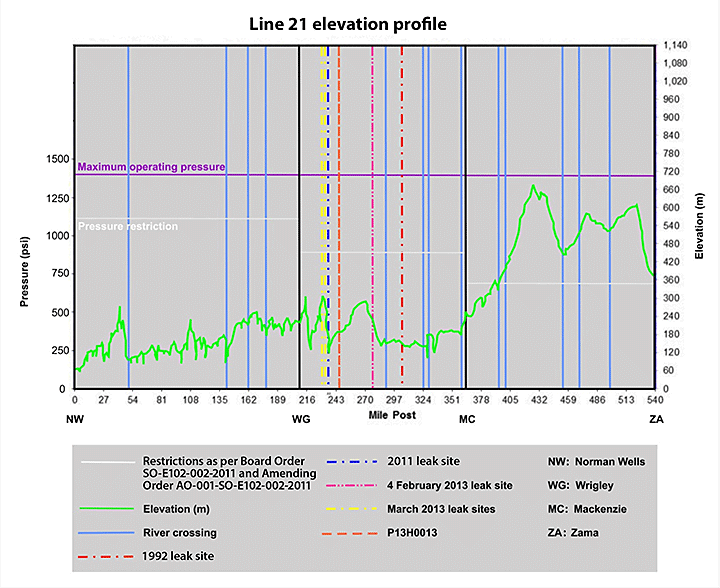Crude oil pipeline leak
Enbridge Pipelines Inc.
Line 21, kilometre post 391
Near Wrigley, Northwest Territories
The Transportation Safety Board of Canada (TSB) investigated this occurrence for the purpose of advancing transportation safety. It is not the function of the Board to assign fault or determine civil or criminal liability. This report is not created for use in the context of legal, disciplinary or other proceedings. See Ownership and use of content. Masculine pronouns and position titles may be used to signify all genders to comply with the Canadian Transportation Accident Investigation and Safety Board Act (S.C. 1989, c. 3).
Summary
On 08 February 2013, a pipeline crew was performing a planned investigative dig at kilometre post 391 of Enbridge Pipelines Inc.'s Line 21, as part of its integrity management program. During the excavation, hydrocarbon odours and a crude oil sheen were noticed at the pipe surface. Further examination revealed a through-wall crack of 3.4 millimetres long at the external pipe surface located near the girth weld. Although no free-standing oil was present, approximately 54 cubic metres of oil-contaminated soil was removed from the site during cleanup.
Factual information
On 08 February 2013, a pipeline crew was performing a planned investigative dig at kilometre post (kp) 391 of Enbridge Pipelines Inc.'s Line 21, as part of its integrity management program. During the excavation, hydrocarbon odours and a crude oil sheen were noticed at the pipe surface. Further examination revealed a through-wall crack of 3.4 mm long at the external pipe surface located near the girth weld. Although no free-standing oil was present, approximately 54 cubic metres (m³) of oil-contaminated soil was removed from the site during cleanup.
Line 21 consists of approximately 869 km of pipe with an outside diameter of 323.9 mm and varying wall thicknesses. This pipeline was being used to transport sweet crude oil from Norman Wells, Northwest Territories, to Zama, Alberta. It has intermediate pump stations at Wrigley and Mackenzie, both in the Northwest Territories, and an injection site in Alberta. The pipeline is operated remotely through Enbridge's control centre in Edmonton, Alberta.
Line 21 had been constructed in 3 segments: Norman Wells to Wrigley (336.35 km), Wrigley to Mackenzie (249.75 km), and Mackenzie to Zama (283.39 km). Pipeline construction occurred during the winter months of 1983–1984 and 1984–1985. The pipeline was put into service in April 1985.
Each of the 3 segments had been pneumatically tested following construction. In each case, after the pressure test, methanol was used to decrease the moisture content in the pipe. In addition, the entire line from Norman Wells to Zama underwent an oil test in April 1985, just prior to commissioning. No leaks were found during either the pneumatic pressure test or the oil commissioning test.
The pipeline
The pipeline section where the leak occurred was pipe grade 359 and had a nominal wall thickness of 6.9 mm. It was manufactured by IPSCO Inc., with a high-frequency electric resistance weld (ERW) longitudinal seam. The pipe was externally coated with extruded polyethylene, which is also referred to as “yellow jacket”.
The leak occurred in the Wrigley-to-Mackenzie segment of Line 21, which had been constructed during the first quarter of 1984. This segment of the pipeline was pneumatically tested in March 1984 to allow for a maximum operating pressure (MOP) of 9896 kilopascals (kPa) (equivalent to 65% of the specified minimum yield strength of the pipe).
Pipeline operations
Based on quarterly pressure-cycle monitoring computations, Enbridge determined that the fatigue development in Line 21 during the service life, up to the date of the detected leak, was light. At an MOP of 9896 kPa, the operating capacity of the line is 630–710 cubic metres per hour (m3/hr). At the time the leak was discovered, the pipeline was operating at 100–110 m3/hr, at a pressure of 2413 kPa (24.5% of MOP).
Laboratory examination of failed pipe
A 5-m section of pipe containing the crack (which was located between the 1:30 and 2:00 positionsFootnote 1), the nearby girth weld, and the associated upstream and downstream pipe segments was sent to the Det Norske Veritas (USA) Inc. (DNV) laboratory in Dublin, Ohio, for metallurgical analysis.
Transportation Safety Board (TSB) investigators participated in the review of the laboratory test protocols and were present at DNV's laboratory during testing. It was determined that DNV's examination was conducted in accordance with industry-accepted standards, and that the work performed and methodologies used were consistent with appropriate failure-analysis practice.
The laboratory examinations included visual inspection, non-destructive testing, fractography, scanning electron microscopy, energy dispersive spectroscopy, hardness measurements, mechanical testing, and chemical analysis.
The laboratory analysis determined the following:
- Diameter, ovality, and wall thickness of the pipe met the specifications that were in effect at the time of manufacture of the pipe.
- The chemical composition and mechanical properties of the pipe met the specifications in effect at the time of manufacture of the pipe.
- The girth weld appeared relatively uniform in appearance and height, and had no obvious start-stop areas in the vicinity of the leak location.
- The leak occurred at a through-wall crack, which originated in the base metal on the internal surface of the pipe in close proximity to the girth weld. The crack measured 3.4 mm in length at the outside diameter of the pipe (see Photo 1) and 18.8 mm in length at the inside diameter of the pipe (see Photo 2).
- The crack morphology was intergranular through 98% of the wall thickness (see Photo 3) and was consistent with internal stress corrosion cracking.
- The residual welding stresses were the most probable source of tensile stresses governing the cracking behavior.
- Crack propagation was by fatigue for the remaining 2% of the pipe wall thickness.
Stress corrosion cracking
Stress corrosion cracking (SCC) is cracking that is induced in a susceptible material under the combined influence of a tensile stress, either residual or applied, and a corrosive environment. An intergranular crack path and branched cracking in the base metal microstructure are among the characteristics of SCC.
Residual stresses can be introduced into the material through welding, cold deformation and forming, heat treatment, and grinding. SCC can occur on the external surface of the pipe or on the internal surface. Internal SCC can occur when there is an internal corrosive environment.
Previous failures on Line 21 attributed to internal stress corrosion cracking
Line 21 has had 2 failures resulting from through-wall features attributed to internal SCC. The first failure was detected at kp 491 on 04 May 1992, and the second failure was detected at kp 380.4 on 09 May 2011. Both failures occurred in the Wrigley-to-Mackenzie segment of the line. In addition, these failures had originated on the internal pipe surface near the girth weld in the upper quadrant of the pipe. In June 2011, the National Energy Board (NEB) initiated an investigation into the May 2011 failure at kp 380.4. This investigation is ongoing.
Below is a summary of the earlier pipe failures, including the follow-up action by Enbridge and the National Energy Board (NEB).
Pipe failure at kp 491 (May 1992)
The pipe at kp 491 was repaired in May 1992, using a PLIDCO split sleeve. In January 1993, a section of line containing the sleeve was cut out and sent to Canspec Group Inc. in Edmonton, Alberta, for metallurgical testing. CANSPEC concluded that the crack had occurred as a result of internal SCC, and that cracking had probably occurred during line testing following construction. Enbridge also had Cortest Columbus Technologies Inc. (CC Technologies) in Columbus, Ohio, perform metallurgical testing on the defect. CC Technologies concluded that the failure had occurred as a result of internal SCC.
Pipe failure at kp 380.4 (May 2011)
The pipe at kp 380.4 was initially repaired in May 2011, using a PLIDCO split sleeve. In February 2012, the section of line was cut out and sent to DNV in Dublin, Ohio, for metallurgical testing. DNV concluded that the crack had originated and propagated nearly to a through-wall state due to SCC, and that final through-wall progression was due to fatigue. DNV noted that, since crude oil and petroleum products are not known to cause SCC, cracking may have occurred prior to commissioning of the line in 1985.
Following the May 2011 failure, Enbridge took several mitigative measures, which included
- pressure restrictions
- weekly aerial patrols for a period of 4 weeks following the 20 May 2011 restart
- 3 axial crack in-line inspections (ILIs), using 2 different tool vendors, beginning in October 2011
- a comprehensive investigation program
- frequent in-line leak detection inspection.
The NEB issued Board Order SO-E102-002-2011 in June 2011, which limited the maximum operating pressure in Line 21 to
- 7735 kPa for the segment from Norman Wells to Wrigley
- 5723 kPa for the segment from Wrigley to Mackenzie
- 5068 kPa for the segment from Mackenzie to Zama.
The NEB required Enbridge to submit an engineering assessment of Line 21 before asking for removal of the pressure restriction, or by 31 December 2012, whichever date came first. The purpose of the engineering assessment was to determine whether or not Line 21 could remain fit for its intended service at the reduced pressures. Enbridge submitted an engineering assessment to the NEB, dated 18 December 2012, demonstrating that Line 21 was fit for its intended service at the reduced pressures.
In August 2012, Enbridge further voluntarily restricted the pressure on the Mackenzie-to-Zama segment to 4744 kPa. The NEB issued Board Order AO-001-SO-E102-002-2011, dated 08 March 2013, requiring Enbridge to submit an engineering assessment of Line 21 that indicated that the pipeline remained fit for its intended service before asking for removal of this pressure restriction or by 31 December 2013, whichever date came first. Enbridge submitted an engineering assessment of Line 21 to the NEB, dated 23 December 2013, demonstrating that the pipeline remained fit for its intended service at the reduced pressures.
In-line inspection for cracks
Between October 2011 and February 2012, Enbridge had Line 21 inspected by an ultrasonic crack detection (USCD) ILI tool. This type of ILI tool contains sensors, electronics, and recording or output functions. This ILI tool is designed to identify axially oriented cracks and crack-like features, such as external or internal SCC, in the pipe wall that meet or exceed length and depth thresholds as specified by the vendor of the tool. The tool's sizing capabilities are such that cracks or crack-like features must meet or exceed both depth and length thresholds to be accurately detected and sized. The depth-sizing algorithm is based on a correlation between the level of sound received by each of the tool's sensors from any given feature and the size of the feature. Once a feature has exceeded a certain depth as specified by the vendor, the sizing algorithm can no longer distinctly estimate the depth based on the ultrasonic signal. The tool would have reached its saturation limit. Features exceeding the tool's saturation limit would be reported as “saturated”. In the case of the 2 tools used on Line 21, the depths corresponding to the saturation limits were 3 mm for one tool and 4 mm for the other. In other words, the tool's saturation limit would not allow it to report any feature as “through-wall”, but would allow a feature to be reported as “saturated”.
Based on its analysis of the leak features from the previous Line 21 failures, combined with other ILI and non-destructive examination data points, Enbridge determined that some deep crack-like features on Line 21 may not meet the ILI tool's minimum-length threshold. Enbridge, then, worked closely with ILI vendors to leverage the capabilities of the tools from a detection perspective and developed a severity ranking system to discriminate between shallow cracks and deep cracks for these short features. Enbridge also determined that, from an analytical perspective, the ILI tools had depth-sizing limitations in the vicinity of girth welds.
In early 2012, based on the results of the USCD ILI, Enbridge identified and completed investigative digs at 19 locations on Line 21. Due to the northerly location of this pipeline, the right-of-way conditions allow for excavation only during ground freeze-up, which typically occurs between the beginning of January and the end of March. The selection of the 19 locations had been based on the detection of internal or external crack-like indications in the vicinity of a girth weld.
In the winter of 2012–2013, 60 additional locations, including kp 391, were identified for excavation (i.e., investigative digs). These locations were identified based on the results of the 2011–2012 USCD ILI, as well as on the results from the 19 investigative digs completed in early 2012. In selecting locations for its dig program, Enbridge developed a likelihood-based approach independent of the ILI tool's sizing capabilities. This approach improved the probability of detecting defects of interest in the pipeline.
During the winter 2012–2013 excavation program, contaminated soil was found at 3 other targeted locations (kp 382, kp 387, and kp 457) in addition to the contaminated soil found at kp 391. These other 3 locations had through-wall cracks, although none of the cracks were leaking at the time of excavation. The cracks were axially oriented, relatively short, and located in close proximity to a girth weld. A section of pipe containing the crack at kp 457 was cut out for further testing. The remaining 2 locations, kp 382 and kp 387, were sleeved and were to be used for calibration and verification purposes (i.e., during subsequent in-line inspections).
Figure 2 provides a graphical presentation of Line 21 (Norman Wells to Zama), including the elevation, maximum operating pressure, pressure restrictions imposed by NEB, and locations of the recent (i.e., 2011 to 2013) pipe sections with contaminated soil.
Experimental test programs for stress corrosion cracking undertaken by Enbridge
Following the May 2011 failure on Line 21, Enbridge undertook an experimental and analytical testing program to examine the effects of methanol as it relates to the environmental conditions necessary for the initiation of intergranular SCC in Line 21 pipe. The results of this analysis were summarized in a paperFootnote 2 that was presented at the proceedings of the NACE (National Association of Corrosion Engineers) conference, CORROSION 2014.
In the laboratory testing program, 13 notched test specimens were machined from a joint of pipe that had been removed from Line 21 in early 2012. Each specimen underwent slow strain rate testing in a solution of methanol, water, formic acid, and chloride. The solution compositions varied between specimens. These solutions were intended to mimic the internal pipeline environment on Line 21 at the time of the 1985 pneumatic test. The following laboratory results were obtained:
- Of the 13 specimens, transgranular cracking occurred in 6 specimens, intergranular cracking in 5 specimens, and no cracking in 2 specimens.
- Transgranular cracking occurred in the 6 specimens that were tested in solutions that had varying amounts of added chlorides.
- The specimens that exhibited intergranular cracking also exhibited secondary cracking.
- The specimen that was tested in a solution containing 4% water by volume did not exhibit any cracking.
Results from these laboratory tests indicate that intergranular cracking can be induced by methanol when the appropriate environment and stress conditions are present.
Other laboratory testing undertaken by Enbridge
Enbridge undertook a laboratory testing project to better understand the radial, axial, and circumferential residual stress distribution in the vicinity of the girth welds on Line 21. The results of these tests indicate that the circumferential residual tensile stresses peaked at approximately 77% of the pipe's specified minimum yield strength (SMYS) at the internal pipe surface.
Enbridge also conducted a full-scale laboratory testing program to characterize the leak initiation pressures and leak rates associated with the through-wall cracks on Line 21. The results of these tests indicate that the leak initiation pressures exceeded the reduced pressure restrictions that were imposed by the NEB on the Wrigley-to-Mackenzie segment of the pipeline.
Analysis
The pipeline failure at kilometre post (kp) 391 occurred at a through-wall crack located near a girth weld. Because the crack had originated on the inside surface of the pipe, the corroding environment necessary for the initiation and propagation of stress corrosion cracking (SCC) must have been provided by the contents of the pipeline. Since the crude oil transported by Line 21 is not known to provide such an environment, the environment was likely present prior to the commissioning of the line in 1985. The laboratory testing conducted by Enbridge indicates that, under specific environmental and stress conditions, methanol-induced intergranular cracking can occur in some pipe steel.
A fatigue failure can occur in pipe due to the repeated imposition of stress at a level lower than the yield strength of the pipe material. Fatigue failures are more likely to occur at a pre-existing defect, such as a crack. In this occurrence, since the depth of the initial crack extended through 98% of the pipe wall thickness, fatigue due to normal pipeline operations caused the crack to grow, even though the pressure cycling on Line 21 was light.
In-line inspection for cracks
Ultrasonic crack detection (USCD) in-line inspection (ILI) tools are designed to identify axially oriented cracks and crack-like features (e.g., external or internal SCC) in the pipe wall that meet or exceed both length and depth thresholds as specified by the tool vendor. In this occurrence, the results of the USCD ILI were used to identify and select locations for Enbridge's investigative dig program. Locations were selected based on specifically designed criteria where crack-like indications of interest were identified in the vicinity of a girth weld. Some of the excavated locations had a through-wall crack; however, because of proximity to the girth weld and limited crack length, among other reasons, the USCD ILI tool could not identify any of the indications as being saturated.
Regarding the defect at kp 391, the analysis of the data from the in-line inspection conducted in 2011–2012 could not identify that the defect was at about 98% through-wall at the time of the inspection and would require immediate repair. Ultrasonic crack in-line inspection tools have difficulties in accurately sizing short defects located in close proximity to a girth weld. As additional measures are required to improve the probability of detecting defects of interest, Enbridge developed a likelihood-based approach, independent of tools' sizing capabilities, to select locations for its dig program.
Findings
Findings as to cause and contributing factors
- The pipeline failure at kp 391 occurred at a through-wall crack located near a girth weld.
- The defect was a result of internal stress corrosion cracking through 98% of the pipe wall thickness.
- The defect had likely initiated prior to Line 21 being commissioned in 1985.
- The methanol used following the pneumatic test at the time of construction had likely produced an internal pipe environment that was conducive to the initiation and propagation of stress corrosion cracking.
- Cracking originated near the girth weld due to the high residual tensile stresses on the pipeline inner diameter at that location.
- The defect propagated through the remaining 2% of the pipe wall thickness as a result of fatigue caused by normal pipeline operations.
Other findings
- The pipeline defect at kp 391, as well as the defects at kp 382, kp 387, and kp 457, were found as part of Enbridge's response and investigation into the leak at kp 380.4.
- Under specific environmental and stress conditions, methanol-induced intergranular cracking can occur in some pipe steel.
- Ultrasonic crack in-line inspection tools have difficulties in accurately sizing short defects located in close proximity to a girth weld.
Safety action
Safety action taken
Safety action taken by the National Energy Board
The National Energy Board (NEB) issued Board Order AO-002-SO-E102-002-2011, dated 22 March 2013, requiring Enbridge to
- complete an additional engineering assessment on the Wrigley-to-Mackenzie segment of Line 21 to evaluate the fitness for service of this segment from a leak-dependent perspective;
- submit an assessment of the currently available leak-detection technologies to determine which is most applicable to Line 21;
- submit a plan outlining how and when Enbridge will implement the selected technology;
- conduct a leak-detection and soil-contamination assessment using boreholes at any remaining excavation sites that would not be assessed before the spring 2013 break-up; and
- continue to consult with potentially affected people, including Aboriginal groups, about the incidents, remediation, and additional measures to be taken on Line 21.
Safety action taken by Enbridge
Enbridge has complied with all of the conditions of Board Order AO-002-SO-E102-002-2011 and incorporated a plan outlining how and when it would implement leak-detection technologies on Line 21 into its engineering assessments. Enbridge submitted the plan to the NEB in June 2013 and December 2013.
Safety action taken by the Transportation Safety Board
The Transportation Safety Board (TSB) issued a safety advisory to the NEB, dated 14 February 2014, notifying it of the preliminary results of Enbridge's experimental and analytical testing program, which involved the effects of methanol on the initiation of intergranular stress corrosion cracking (SCC) in pipeline steel.
In response, the NEB indicated that, as methanol has been successfully used as a drying agent during pipeline commissioning, further analysis must be conducted to confirm other factors contributing to cracking.
As well, Enbridge indicated that the use of methanol has been shown to potentially cause SCC when sufficiently high stresses are present at the location and the concentration of water is lower than that proven to inhibit SCC.
This report concludes the Transportation Safety Board's investigation into this occurrence. The Board authorized the release of this report on 05 November 2014. It was officially released on 04 December 2014.
